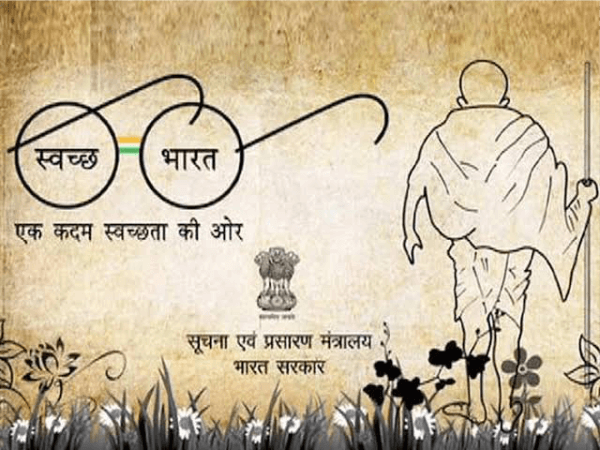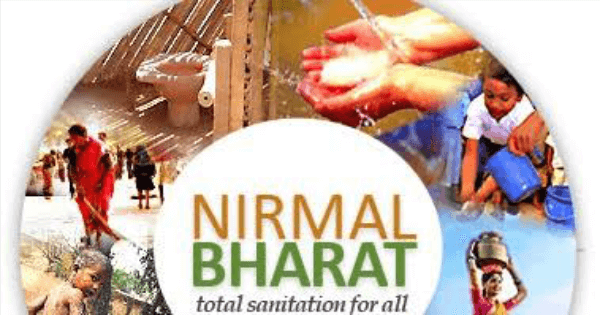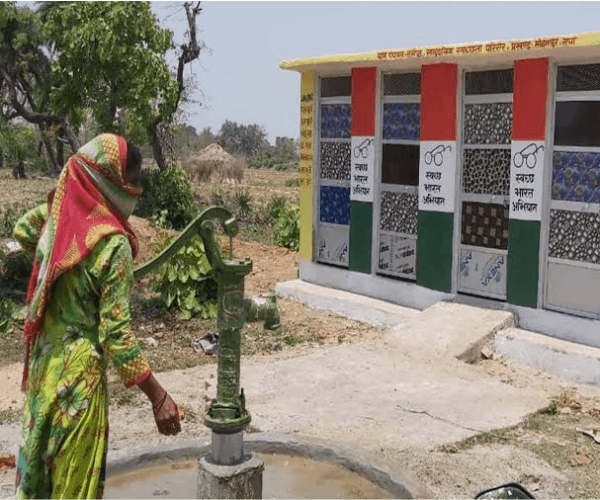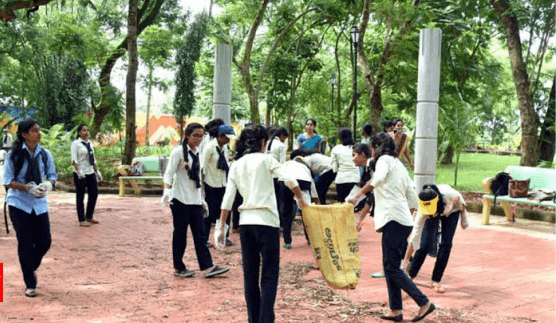Swachh Bharat Abhiyan EssayThe Government of India launched the Swachh Bharat Mission (SBM), Swachh Bharat Abhiyan, or Clean India Mission, in 2014 as a national initiative to end open defecation and enhance solid waste management. It is a revamped version of the Nirmal Bharat Abhiyan, a 2009 initiative carried out by Manmohan Singh's successor, but which fell short of its goals. The Swachh Bharat Mission's first phase ended in October 2019. To assist cement the work of Phase 1, Phase 2 is being implemented between 2020-21 and 2024-25. 
In 2011, the Census showed that sanitation coverage in rural India was only 34%, as measured by the number of households with toilets. An estimated 600 million people defecate in public, the most of any country on the planet. Coverage of open defecation and contaminated drinking and bathing water in India prompted the government to take action to address the issue. The Indian government started the project with the goal of making India "open-defecation free" (ODF) by 2 October 2019, the 150th anniversary of Mahatma Gandhi's birth. During that time, an estimated 89.9 million toilets were constructed. Aside from eliminating manual scavenging, raising awareness about sanitation standards and changing people's behaviour were also goals of the mission's first phase. Another goal was to increase local capacity. In order to maintain the public defecation-free status and enhance the management of solid and liquid waste, the mission's second phase also seeks to enhance the working conditions for sanitation personnel. The mission is intended to advance toward target 6.2 of the sixth Sustainable Development Goal, which the United Nations established in 2015. Hindi is used for the campaign's official name. It means "Clean India Mission" in English. Prime Minister Narendra Modi formally inaugurated the campaign on October 2, 2014, at Rajghat in New Delhi. With three million government workers and students from all over India participating in 4,043 cities, towns, and rural villages, it is India's largest cleaning initiative to date. The campaign was named Satyagrah se Swatchhagrah by the Prime Minister at a rally in Champaran in honour of Gandhi's Champaran Satyagraha, which began on 10 April 1916. The mission was divided into an urban and a rural area. While "SBM- Urban" was under the direction of the Ministry of Housing and Urban Affairs, "SBM- Gramin" was funded and overseen by the Ministry of Drinking Water and Sanitation in rural areas (which has since been renamed the Department of Drinking Water and Sanitation under the Ministry of Jal Shakti). As part of the program, volunteers encouraged the building of toilets utilising the well-liked technique known as Community-Led Total Sanitation at the village level. These volunteers are known as Swatchhagrahis, or "Ambassadors of cleanliness." The Ugly Indian, Waste Warriors, and SWACH Pune, among other non-governmental organisations, provide real-time monitoring and updates on a national level (Solid Waste Collection and Handling). Between 2014 and 2019, the government funded the construction of approximately 90 million toilets, yet some Indians, particularly those in rural regions, have chosen not to use them. The campaign came under fire for adopting coercive tactics to have people use the restroom. Some people were warned they might lose their government benefits if they continued to urinate in public. The Indian government and state governments contributed to the campaign's funding. For the construction of toilets in 700,000 communities, the former organisation released $5.8 billion (Rs. 40,700 crores). The expected $28 billion budget for the rural and urban components was split 93% for building and the remaining portion for administration and behaviour modification initiatives. Previously Conducted Sanitation Initiatives
The Central Rural Sanitation Program was initially introduced in 1986, after the first formal sanitation program was originally introduced in 1954. These had minimal success and were construction driven. The Total Sanitation Campaign (TSC) and Nirmal Bharat Abhiyan were launched in 1999 and 2012, respectively, to create demand for sanitation and tie it to subsidies for low-income families building toilets. A small, randomised study of 80 rural Madhya Pradesh villages revealed that the TSC program did somewhat increase the proportion of families with latrines and had a negligible impact on the prevalence of open defecation. Nearly 3.5 million of India's 138.2 million rural households (as of 2001) built toilets. The health of kids didn't become much better, though. The unrealistic strategy hindered the earlier "Nirmal Bharat Abhiyan" rural sanitation program. As a result, Swachh Bharat Abhiyan was established on September 24, 2014, with Cabinet approval, replacing Nirmal Bharat Abhiyan. In India, the percentage of rural households with access to toilets climbed from 1% in 1981 to 11% in 1991, 22% in 2001 to 32.7% in 2011. 96.5 per cent of rural Indian households, according to the National Annual Rural Sanitation Survey, possessed toilets. The figure was decreased to 1.4 per cent, or 19 million, in a 2019-2020 study. The Government of India has achieved outstanding progress toward achieving the Open Defecation Free objectives since 2014. As of January 2020, there were more than 603,175 villages, 706 districts, 36 states, and union territories that had been proclaimed open defecation free. In just five years, India has built an astonishing number of toilets under SBM. SBM drew on the past sanitation programs where it had some success. It improved their methods and templated the district-level action plan. Beginning in the early 2010s, a number of district collectors and magistrates from Rajasthan to West Bengal tried out various techniques to involve the local populace and panchayats in community mobilisation. They chose the swachhagrahis, gave them training, and then on a set schedule, released them for campaigns. They received payment from the sanitation budget. These steps were successful in states with robust panchayats, and the benefits of cleanliness, such as toilet construction, were supported by usage. Beyond building toilets, not much was accomplished in other states. Goals
Reducing open defecation and enhancing municipal solid waste management in both urban and rural areas were the main goals of the mission's first phase. The development of individual household-level latrines (typically twin pit pour flush pit latrines), toilets, and public latrines were intended to end open defecation. Cities were urged to create thorough project reports that are bankable and have a financial model in order to improve solid waste management. On the other hand, the second phase emphasises maintaining successes from the first phase and enhancing the management of solid and liquid wastes. FinanceSBM had a $28 billion budget. For each toilet built by a rural family, the government offers an incentive of 12,000 (US$150). In India's 2016 Union budget, a sum of 90 billion (about US$1.1 billion) has been out for the project. In order to facilitate India's introduction of universal sanitation, the World Bank gave the Swachh Bharat Mission a loan of US$1.5 billion and $25 million in technical assistance in 2015. A separate verification organisation was supposed to review each instalment before it was released; however, as of January 2017, no money had been paid out. Additionally, the Sarva Shiksha Abhiyan and Rashtriya Madhyamik Shiksha Abhiyan programmes, together with a number of international organisations and private businesses, have provided financial and technical support for the programme. Prominent Figures and Brand AmbassadorsPrime Minister Modi chose the following notable figures to support this campaign in early 2014:
The message was delivered to Uttar Pradesh by the prime minister on November 8th, and nine more candidates were proposed for that state.
2015 The ministry in charge proposed the following Telugu celebrities as brand ambassadors on January 5.
In 2017 and 2018, Prime Minister Modi then named the following prominent figures and celebrities as National Brand Ambassadors to join and promote the Swachh Bharat Mission:
Other Noteworthy Events Include:
Effectiveness
The Swachh Bharat Mission (SBM) mobile app is utilised by citizens and government agencies to further the mission's objectives. Through commercials, the Indian government is raising public awareness of this issue. In 2017, 65 per cent of the country had access to sanitary facilities, up from 38.7 per cent on October 2, 2014, before the campaign officially began. In August 2018, 90% of it was the case. By 25 September 2019, 699 districts, 5.99 lakh (599,000) villages, 35 states and union territories, and ODF status had been achieved. The percentage of urban wards with 100% door-to-door solid trash collection was 50%, while the percentage of cities and towns that have been designated as ODF was 22%. There are now 20,000 Swachhagrahi volunteers working for urban local governments, while there are over 100,000 volunteers working in rural India. There are now over one million schools with separate restrooms for girls, up from 0.4 million (37%) in 2010. The Annual Swachh Survekshan Cleanliness SurveySwachh Survekshan is a comprehensive sanitation survey of several hundred cities that the Quality Council of India was contracted to conduct on behalf of the Ministry of Urban Development in order to assess the effectiveness and progress of the Swachh Bharat Abhiyan and to promote a spirit of competition among the cities. Six factors are used to assess each city's performance:
ImpactsMore than 100 million individual household-level toilets have been built in rural areas, while 6 million household toilets have been built in urban areas, according to the dashboards kept by the various ministries. In addition, there have been built over 6 million public and communal restrooms in urban areas. As a result, 4,234 cities and more than 600,000 villages nationwide have proclaimed themselves to be open defecation-free (ODF). Urban areas now have more than 81.5 thousand wards with 100% door-to-door collection of solid waste and approximately 65 thousand wards with 100% waste source segregation. Sixty-five per cent of the roughly 150 000 metric tonnes of solid trash produced in metropolitan areas are being treated. According to an independent survey conducted by the Quality Council of India and published in August 2017, the overall country's rural "household access to toilet" coverage increased to 62.5 per cent and toilet usage to 91.3 per cent, with Haryana topping the list with 99 per cent of covered rural households and 100 per cent toilet usage. The number of people without access to a toilet dropped from 550 million to 50 million, according to UNICEF. According to the World Bank, 96% of Indians who have access to a toilet use it. According to a report by the World Health Organization (WHO), the Swachh Bharat Mission has prevented at least 180,000 deaths due to diarrhoea in rural India. A survey conducted in 2018 and released in 2019 by the National Statistical Office (NSO) found that, as of 2018, 71% of rural households have access to toilets. NSO's data showed a significant improvement over the condition during the preceding survey period in 2012, when just 40% of rural households had access to toilets, even if this was at odds with the Indian government's assertion in 2019 that 95% of rural families had access to toilets. According to a study by Ashoka University, the installation of restrooms as part of the initiative decreased the frequency of sexual assault against women. The mission is known for having the biggest cleanliness programme in the world. It claimed to have given millions of people access to lavatories and changed people's attitudes toward using them. Many contend that despite what the government states, open defecation has not been completely eradicated. It did, however, dramatically quicken the rate of open defecation drop.
Next TopicNational Integration Essay
|
 For Videos Join Our Youtube Channel: Join Now
For Videos Join Our Youtube Channel: Join Now
Feedback
- Send your Feedback to [email protected]
Help Others, Please Share









